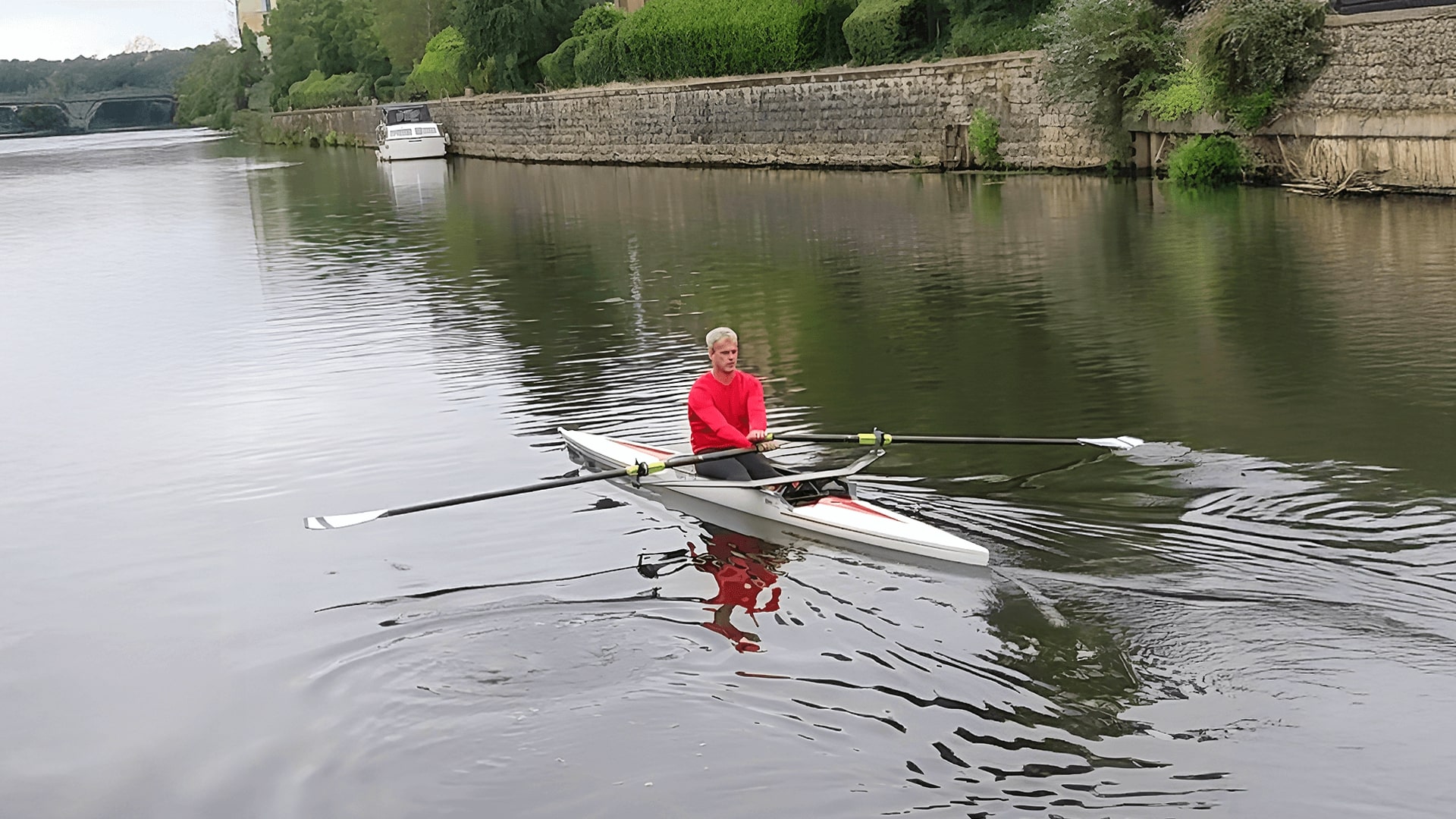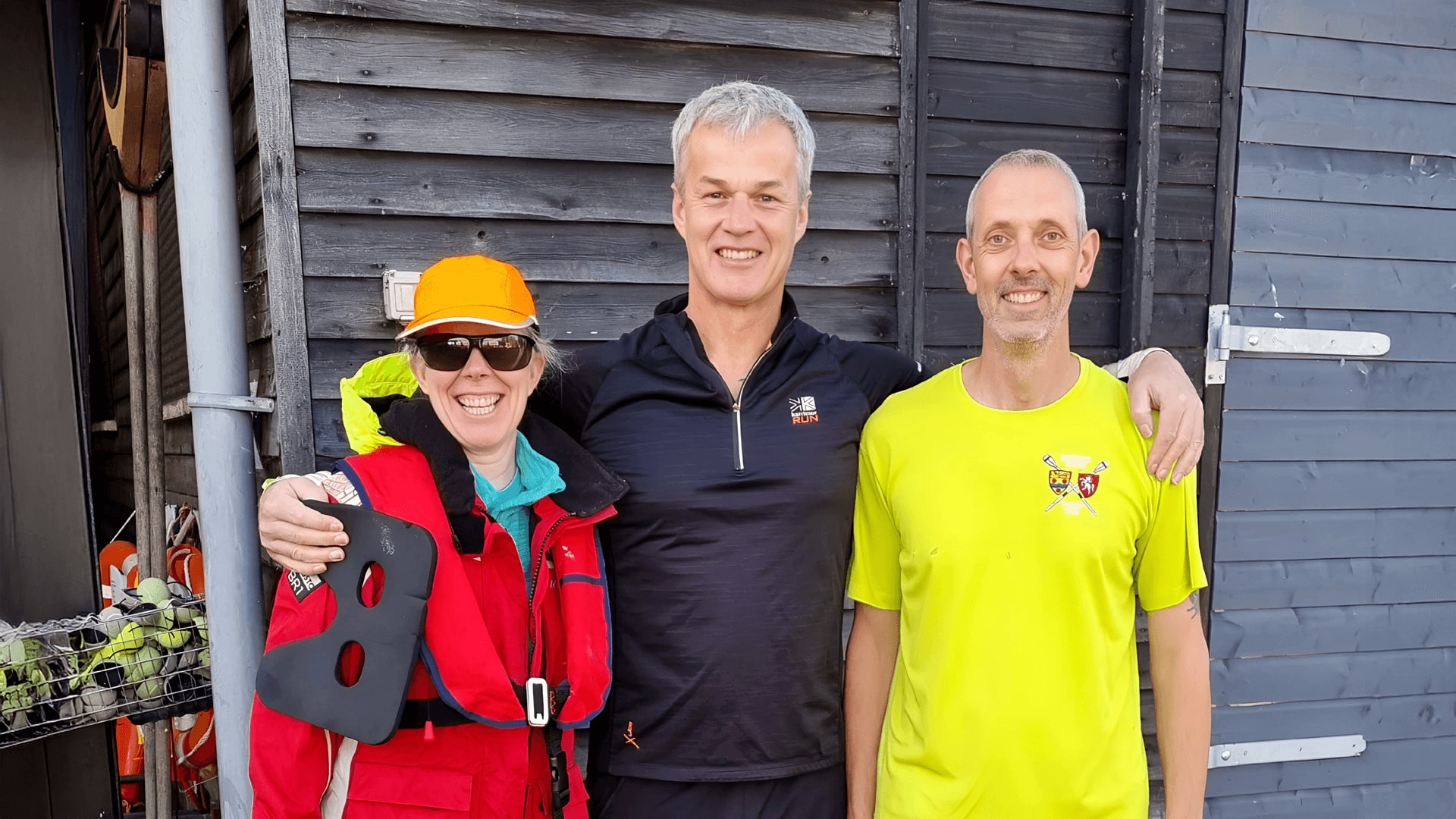How indoor rowing inspired me to row on the water (and catch crabs)

read
This is an account of my journey from newbie erg user to actually rowing on the water. Hopefully, my story will confirm or dispel some of those (indoor) rowing myths we all know. Like the ‘you can’t get wet on an erg’.
Oh, we can put this one to bed very early: at about 12 minutes on the rower, I’m soaked without a river or lake in sight (apart from EXR’s virtual one).
My testimonial may answer some queries for those of you wondering how to start outdoor rowing as someone who only rowed indoors. For others, it will simply be a source of light amusement and for some, a regret they read about some nut case rambling about sport. Anyway, enjoy the read!
From a young age, I’ve enjoyed sports; playing basketball and cross-country in school, winning squash in college. I’ve also tried boxing (resulting in being severely concussed, but I know my opponents’ hands were sore that day), running, cycling, swimming, rugby, and so on. In my late 20s, I took a shine to triathlon.
I owe much of my fitness to many people, especially Ronnie McWilliams, an exceptional runner and former Scottish champion I trained with at Royal Air Force (RAF) Waddington. Andy Fisher, ‘Fish,’ was, of course, an exceptional swimmer. I should also mention Rick Collard, an age-group champion who provided me with my foundation knowledge of sport. His great contribution continued whenever I saw him, including dropping back on a mountain climb up Mount Troodos to ride with me for the last hour. He single-handedly, and in one weekend, transformed my swimming from diabolical to passable.
I trained hard and competed a lot.
This let me compete with the ‘you can do it’ approach to sport and life. I trained hard and competed a lot. I last raced in the Cypriot international triathlon as part of the RAF Team. I think I got a sympathy place! Finished 16th, so not too shabby.
How my Ironman training turned into indoor rowing sessions
Shortly after leaving the forces, I had a bad accident while out on my bike. It put pay to sport for a number of years. Then in 2019, after a few more accidents, I decided that before I was too old or broken, I wanted to train for an Ironman Triathlon. It was in the first few weeks of training… and guess what: another accident. Oh, how I laugh at the pain and misery. Unfortunately, this time I ended up with a fractured spinal process and four prolapsed discs.
Now, after wiping the tear away, I knew I needed to do four things:
- Get fit
- Lose weight
- Give myself a physical challenge without aggravating my back
- Keep my good lady wife interested, arguably, this is the top priority
During the pandemic, I bought a rowing machine because I was swept up in the home fitness movement that was taking place. I got an old Concept2 Model C with a PM 3 second-hand. Like many people that buy fitness equipment, the rowing machine took turns at being a home fitness machine to dusty ornament. I might do a month of two or three erg sessions a week to no rowing for about two months.
This trend continued for a few years. I would get the rower out and have no real idea of what I was doing. I would look at numbers and slide up and down the rail just to put it away again. That is, until I discovered ‘Dark Horse Rowing’. I watched countless YouTube videos and rowed along to build the basic stroke and understand how I should row.
Then by chance I came across John Steventon of RowAlong on YouTube. His style of teaching worked with my brain: simple and effective. John would talk as he rowed, constantly reminding me of what I should be doing, watching out for this, that and the other. John’s indoor rowing teaching method was perfect for me.
So I started watching videos of John and found a few that I really enjoyed doing. Coupled with the desire to improve, I started erging regularly. In the summer of 2024, I was starting to achieve some okay times for a middle-aged fat bloke, and the magic figure of being able to get below 2:00 for 500 meters was in sight.
I ended up having an email and WhatsApp exchange with John where he analysed a video of my erging. The response I got was nothing less than remarkable, a full analysis of my indoor rowing technique. I can’t emphasise enough how this helped with my stroke. Armed with this feedback and my stubbornness, I achieved my first 5K at 2:00/500.
Discovering EXR and the power of community
I was still just erging to YouTube videos following John’s stroke and emulating his movement, listening to his rowing technique advice, until in one of the videos John mentioned this interactive rowing platform EXR. I knew, I needed another dynamic to keep me engaged, so I signed up for the free trial.
Now at this point I’m not about to endorse and praise EXR as the most wonderful thing, no.
I don’t participate in social media and my bias got the better of me when it came to an online social rowing platform. During EXR’s trial period, I was erging at off-peak times. I rowed alone on the courses. It was fun to watch the avatar, but at that moment I didn’t see the real added value so it was just the one session and only for 4-5 km. Later, I went back to chasing dots on the ErgData app.
EXR provided a whole new dynamic to my erging. This was when I understood that there are thousands of other like-minded nut jobs that rock back and forth gently to exercise their bodies.
It was about this time I started working from home four days a week and found that I could get on the Concept2 at about 6 PM, given I had no commute. I could even row before work if I wanted and still be at my workstation by 7:30 AM! But, I wanted more than chase dots, so I decided to try EXR again. I still had one free trial session from when I had signed up earlier in the year. So that’s exactly what I did: I joined a Saturday group session, December 2024.
Now, this is where I will and do endorse EXR!
It was at this session I realised the power of the social aspect of EXR. It was a turning point! EXR provided a whole new dynamic to my erging. This was when I understood that there are thousands of other like-minded nut jobs that rock back and forth gently to exercise their bodies, in a sympathetic manner or like a complete nutter, to end up in a sweaty pool of their own body fluid. I am of the latter.
After this group session, I signed up and subsequently did another group session. During the second session, there were a couple of people that contacted me through EXR’s Discord Community channel. Eventually, I was back to rowing on a course with no company and back to wondering what all the fuss was about when suddenly Torsten Thau from Germany popped up and started virtually rowing with me! How cool was this!
He was keeping my pace for about 5 km. This was really encouraging in a way that can’t be described. A funny thing I learnt after was that he had already completed a workout and was doing it purely to keep me company and provide encouragement. How nice is that!
This is something I’ve found on the EXR platform and with erging: people who do it are a niche bunch and all seem to be like-minded, encouraging enthusiasts. They’re simply so incredibly positive, even after eight months I still tend to question it, but the community is just truly that wholesome.
So, after joining EXR in December, my occasional 5 km erging increased exponentially.
I started doing some 10 km rows. I think I did them 5 times in the first week. Through EXR’s Community, I met Casper A. Blom, a former competitive rower from the Netherlands and J. Driessens from Belgium. Casper was having an open chat about rowing a half-marathon with Jeroen and Torsten who called me ‘crazy Englishman’. About two weeks after I subscribed to EXR, I decided to give it a bash, too.
My first indoor rowing half-marathon event is a vivid memory for many reasons of discomfort.
I ended up with some serious chaffing discomfort at about one hour in (trust me, no further detail required). But I held on to the end. My first half-marathon event is a vivid memory for many reasons of discomfort, but also being amazed watching Jeroen and Casper up the rate in real-time at the last few kilometres to low 1:50/500, culminating in Jeroen pulling 1:30/500 something across the finish. His new nickname is “Power Oars”. Even Torsten who is a stalwart for helping others along got swept up and disappeared in the last few minutes.
I would not have even realised rowing a half-marathon was a thing or even thought about doing one previously. However, having these guys live on screen pulled me round, much like Rick on the mountain back when I did triathlons.
I’ve gone on to erg many sessions with the Three Amigos as they will be affectionately termed. Casper known for his distance prowess. Torsten for always just being there, encouraging everyone. And Power Oars generally hunting rowers down, pushing the pace and rowing at inhumane speeds!
There are others, too numerous to mention, that I have trained with and there is always someone to erg socially.
All this improved my erg time and by now, my splits are reasonable for a robust 50-something. I erg regularly on EXR. With company most of the time, and sometimes solo if I don’t feel like it. EXR has made erging more fun and interactive. The really great thing is that it's live, think Zwift for bikes equivalent, but for RowErgs. In late spring, my natural progression was to see if I could convert my new erg ability to OTW. I mean, how different could they be?
Outdoor rowing for beginners: transition with ups and downs
Consequently, I took a beginner rowing course at Maidstone Invicta Rowing Club (MIRC). I’ve never been on a boat, other than a ferry as a young child, but there's no advantage to that. It was a course run by the local rowing club and for a minimal fee, they provided two weekends of training which included not only the training by seasoned coaches but also tea, coffee, and biscuits. I was vegan back then, so missed out on the biscuits!
The rowing course consisted of three fairly full days and ran from class-based Health and Safety to getting into a boat and ‘rowing’. On day two, we got into a boat. At this point, I wondered if the erg power and form was transferable on the water (OTW) and if yes, whether I could showcase my skills.
Wrong. No showcase!
At that moment, I thought “kids do this why can’t I?”
In fact, very little rowing. But not due to the lack of trying. At that moment, I thought “kids do this why can’t I?” After a good night's sleep, I could make the blade sort of go in and out of the water, so this could be my chance to showcase erg skills. No, no this was not the time either, not knowing the blade journey through the water was the issue.
This was when I was introduced to the phrase catching a crab. I was a natural at this. Without effort or intention, I could catch crabs easily. I had an efficiency at catching crabs that’s consummate with someone that had practised for a long period. Alas, catching a crab is not a good thing!
From those very early days three months ago, I have gone on to be coached by a number of the masters at the club including ‘Huggy’ Mark, both Richards, Charles, Darren and Danny, Clive, Kevin, Ollie, Nadia, James, Robin and others. This small circle of people, doing a sport they love and freely giving their time to teach and encourage others, represents human nature at its finest. Beyond the coaches and the members of the club I’ve chatted too, all are really nice, helpful people that just have a positive outlook and a passion for the sport even after decades of doing it.

I have been fortunate enough to row with a few masters crews in a quad filling any available seat. This gave me the chance to observe the people around me, listen to their advice and try to emulate what they do.
It still amazes me how fluid these rowers are. Their skill level is something to be respected. Each one of them has something useful and unique to pass on and all without exception always say they are still learning, still improving.
Given some have been rowing for over 40 years, I have a long, long, long way to go!

I’m now rowing regularly with Julie, Lyudmila, Arun and Becky, under club tuition as part of the development programme. It’s going well for three months in, we can get in and out of the boat. Not so gracefully at times, but we manage to move the boat up and down the river, slowly and wobbly. We can even catch crabs, rush up the slides, and not square our blades – all on our own!
How indoor rowing lays the foundation for outdoor rowing
The big topic here is the transfer of skills from erging to on-the-water rowing. There is some useful sort of crossover that you will have naturally going from an erg to OTW, but there are also big differences between outdoor and indoor rowing.
First and foremost, the movement of drive with the legs followed by the pivot and finish with the arms is a massive aid in the boat. It is one thing that you do instinctively. This allows your brain to deal with the question: “What am I supposed to do with these rowing sticks?” I noticed that the others on the course had difficulty with this sequence, and along with everything else, it made it an even greater technical challenge to combine all the movements.
Secondly, the fitness. I think of the erg as a pure fitness piece of equipment that trains similar muscle groups to actual rowing. It helped a lot being relatively fit and specifically “erg-fit”. This is because you can concentrate on the oar movement, doing what you're being told, without struggling physically. But make no mistake, you use a lot more core actually rowing, and for me, I found chest muscle, too. It’s a pushing sport!
These are two big advantages to erging before learning to row. But there is a whole raft (no pun intended) of items that no amount of erg-time can prepare you for. For those considering rowing: stick with it for about six weeks and things will start to fall into place.
I find being outside on a river with the rhythmic nature of every stroke in great company very alluring.
The oar position becomes more natural; the balance becomes less of an issue, the timing starts to work and you can showcase some of that erg power on occasion by really catching a crab with gusto!
But make no mistake, the erg is not rowing.
The bit you don’t see when you watch rowing can’t really be explained. There are still too many technical aspects for my little brain to process how to row faster on the water, let alone do. That’s why I can say that it is the most technically demanding sport I’ve ever tried… by a country mile!
Despite this technical demand, I’ve come to be very fond of rowing. I find being outside on a river with the rhythmic nature of every stroke in great company very alluring. The challenge to get that one perfect stroke every time, making small adjustments to improve and so on is not comparable to being on the erg and nor should it be.
Equally, I enjoy erging, pushing my old fat body to the limit of its ability and this motivation with continuing to erg after discovering actual rowing is only possible, for me, with the addition of EXR. I would struggle to go back to chasing dots or watching numbers on a PM.
As the winter draws near and there is less chance to row, I’ll be erging a lot more on the virtual waters of EXR to keep fit, starting with the Concept2 Fall Challenge as part of the club team.
If you are in Kent (UK) and want to try rowing, I would suggest checking out Maidstone Invicta Rowing! And to join the Three Amigos and me on EXR, simply sign up for free!
